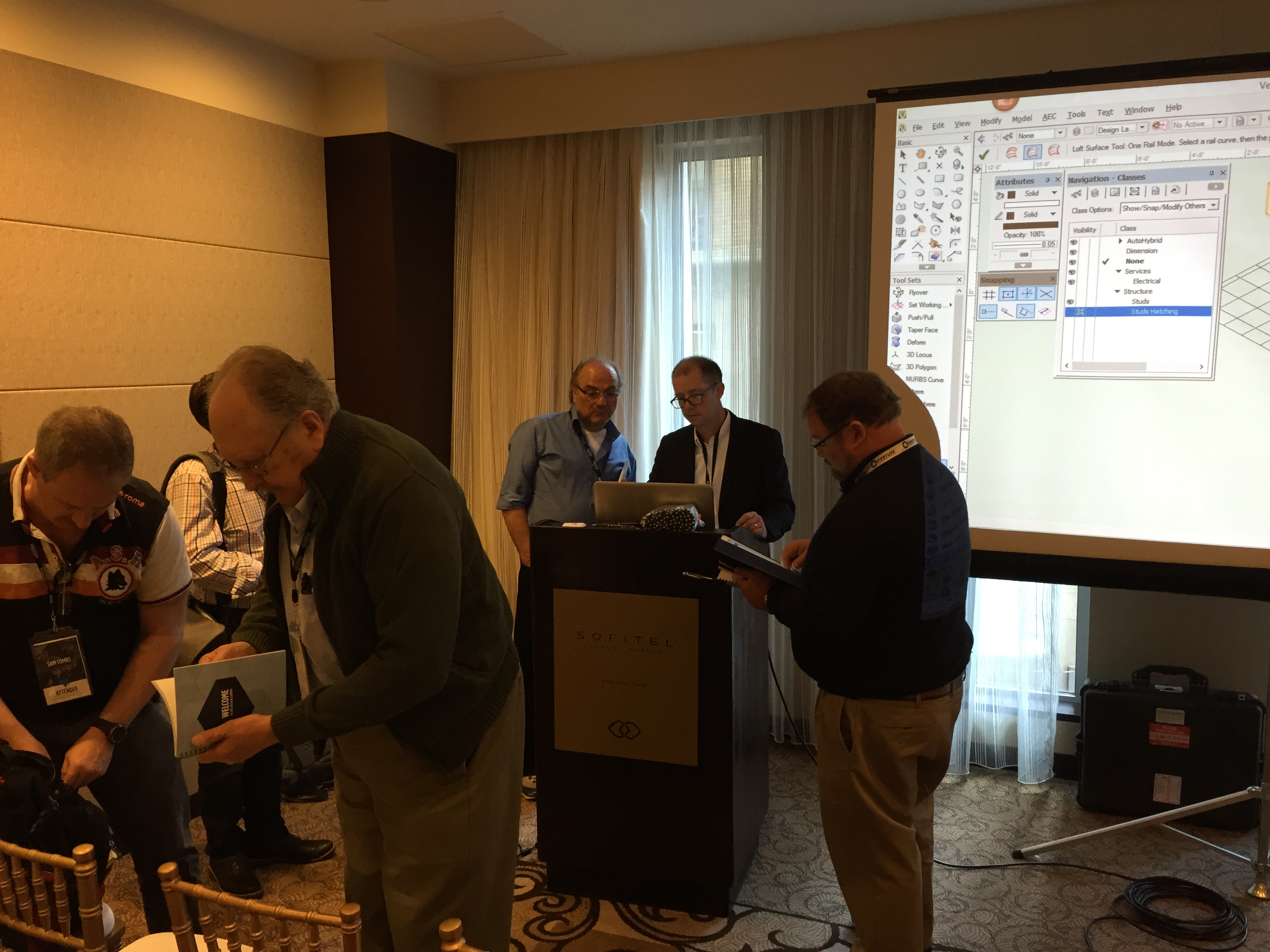-
Posts
3,958 -
Joined
-
Last visited
Content Type
Profiles
Forums
Events
Articles
Marionette
Store
Posts posted by Jonathan Pickup
-
-
making dinensions not snap to each other would make it hard to line up dimensions that you create at different times, or when you want to move a dimension to line up with another dimension.
For me this would be a bad thing...
If you are having trouble snapping to dimensions when you are drawing, there are two suggestions that I have:
1. set up a custom dimension style so that your dimension lines are further away from the object ( or so close that they are touching the object)
2. zoom in closer so that you avoid snapping to the wrong object...
-
I have been using interiorCAD for a little while now and i can tell you that if you want a package that will draw and detail kitchen cupboards then it is the one for you.
I agree that interiorCAD is serious money, but then it is a serious product. It has a great range of tools and tricks. I have been able to make door and drawer units, corner units of any shape, you can control nearly everything about the unit, even where the door handles are located...
-
I drew an odd shaped house a little while ago.It had 4 main parts. One part was orthogonal, the other 3 parts were at different angles, none of them the same as each other.
I kept all the walls, foundations, roof framing, electrical, floor finishes etc, on the same later. I did not rotate parts, nor did I break up the building into layers and re-combine the plan with layerlinking. the reason is that it?s too hard to join walls with the parts on different layers. And then what if there is a change to the plan?
I found that that the walls were the hardest bit to get right, notes and dimensioning were easy. To get the walls to the right angle I drew a construction grid and made a symbol of it. That way the grid is not moved accidentally, and you can use it on different layers if you want. Then I drew the walls to the construction grid. I used the construction grid on a drawing of it?s own to show the contractor how to set out the building.
This method worked OK for me...
-
i would leave it the way that you have it.
Is there a problem with the way that it displays?
Even if you made the wall go up through the 3 stories, you would have other challanges, such as how to edit the window in the middle floor, how to make the wall appear on the 3 plans...
-
what?s wrong with the 3 walls, are they for different floors of the building?
-
please remember that layers in AutoCAD are similar to classes in VectorWorks. So what you need is a tool to turn off a class by clicking on an object.
I wrote of these tools for myself.
-
the name is dislayed if you change to the Data Pane on the Object info palette
-
fill
in Architecture
i can?t remenber if the No Fill Behind text has an effect on this object but you could try it. It?s one of the VectorWorks preferences
from the Menu Bar > File > Preferences > VectorWorks preferences...
Then Edit, or Display tab I think.
-
the negative velocity is what would be required to move from one view to the next. Sometimes you can move the sliders up and down to get rid of the negative velocity, but if this doesn?t work then you need to amend the views.
You can?t just have any views and hope that it will make a good movie. The movie has to tell a story, and the story has to unfold...
check the views, do you have any that would require the camera to move backwards to get from one to the other.... That would be the problem area.
-
I have very few desing layers, I use a lot of classes to control the drawings. I have one layer for each floor of the building, one layer for the site plan, one layer for all the sections, elevations and details...
-
use the title block symbol everytime, it is much more reliable that the design layer method. when you make it into a symbol, you can make it issue manager frieindly and then you can use it with the issue manager to control all the title blocks in the file...
if you don'tknow how to make a title block symbol, check out my Architect Tutorial. It covers how to make the title block symbol, what the issue manager is all about and how to make your title block issue manager friendly.
-
classes, i have a tool that turns off classes for me.
I put the notes and dimensions for the RCP on the same class. when you turn off the notes, the dims turn off as well.
if you tell the symbols what class to be on when you make them they will automatically go on that class.
If you set up the wall type library correctly, walls will be drawn on the correct class for you without any more work...
-
Set the page size that you want using the page setup command.
print to PDF.
When you print from Adobe Acrobat reader; go to the page set up and set the correct page size.
Then when you print make sure that you turn off the page scalling (otherwise acrobat will shrink the pages).
-
I would forget about saved views (they are not called saved sheets any more) and use sheet layers exclusively for setting up drawings.
I think that you may need someone to show you how to put ViewPorts onto a sheet layer to make up drawings. Have you watched some of the NNA movies on ViewPorts?
-
this has been replaced by the boomerang mode. With a tool selected, holdyour thumb on the space bar. Use a finger to hit the X key. Select the object you want (still holdong down the space bar...)
now let go of the space bar.
You jump back to your last tool.
-
I think they have improved the Nudge by making it work with the shift key. It?s a lot quicker and can work with the reshape tool (lasso mode) which wasn?t possible with the older way.
Also try holding down the shift+Apple+arrow keys. This will nudge it one snap grid spacing.
-
I would suggest that instead of exporting a JPG for your printers to print from, try printing as a pdf. If you are on a Mac then printing to pdf is easy,, if you are on a windows machine then you need a pdf printer which I think has been talked about on another part of this list...
http://www.go2pdf.com/products.html
http://downloads-zdnet.com.com/3120-20-0.html?qt=pdf+printer&tg=dl-2001
-
all those views were generated from one design layer, and there is only one sheet layer. If I change the layout of the kitchen of the deck, then all the viewports will be up to date.
Try making the two top left drawings on the same sheet, the show the same floor plan with different classes on each viewport.
Maybe you really need to see the file to appreciate the beauty of using ViewPorts to create drawings. Then you could see how the file was made...
Robert, do you want this file as an example of ViewPorts?
-
it sounds as if the file uses old drawing label PIO?s that are not present in your current version of VectorWorks. Check to make sure that the PIO is in the VectorWorks folder.
-
when you start a job you can set up the dimension class to to have the line weight that you want. I have mine set to 0.18mm and it looks fine to me. Make sure when you do this that you tick the option on the class box to Use At Creation:

This will mean that every dimension you create from now on will be controlled by the class settings. When you want to chage a dimension, go back to the class dialog box, edit the line weight and all the dimensions will change.
While I'm the topic, you should do this with many of your classes and set this up in your layer and class standard. (for more information on layer and class standards please refer to the Architect Tutorial https://vesta.safe-order.net/archoncad/manuals/manuals.php)
-
i would not worry about leaving vW10 behind. I have not missed VW10 at all. the new concepts of sheet layers and viewports makes the creation of drawings really easy, amost a pleasure!
Viewports allows you to create a drawing that shows different parts of the plan at different scales, and with different class settings for each viewport.
My opinion is that to use the power of the viewports you need to look at a new way of setting up your drawings. But when you do, you will find it a joy.
this image shows a drawing that was created with one model layer. the viewports have different scales, different classes turned on and off, and even different view directions.

-
i would not worry about leaving vW10 behind. I have not missed VW10 at all. the new concepts of sheet layers and viewports makes the creation of drawings really easy, amost a pleasure!
Viewports allows you to create a drawing that shows different parts of the plan at different scales, and with different class settings for each viewport.
My opinion is that to use the power of the viewports you need to look at a new way of setting up your drawings. But when you do, you will find it a joy.
this imag
-
you upload the picture to a web site then you add the link by using the full reply form. there is a button there for add image.
-
this is the place to make the change:




OpenGL rending not retained during rotation
in Solids Modeling
Posted
From the menu bar choose File > Preferences > VectorWorks Preferences then choose the 3D tab.
Drag the Retain Rendering Model all the way to the right.
Does this fix it?